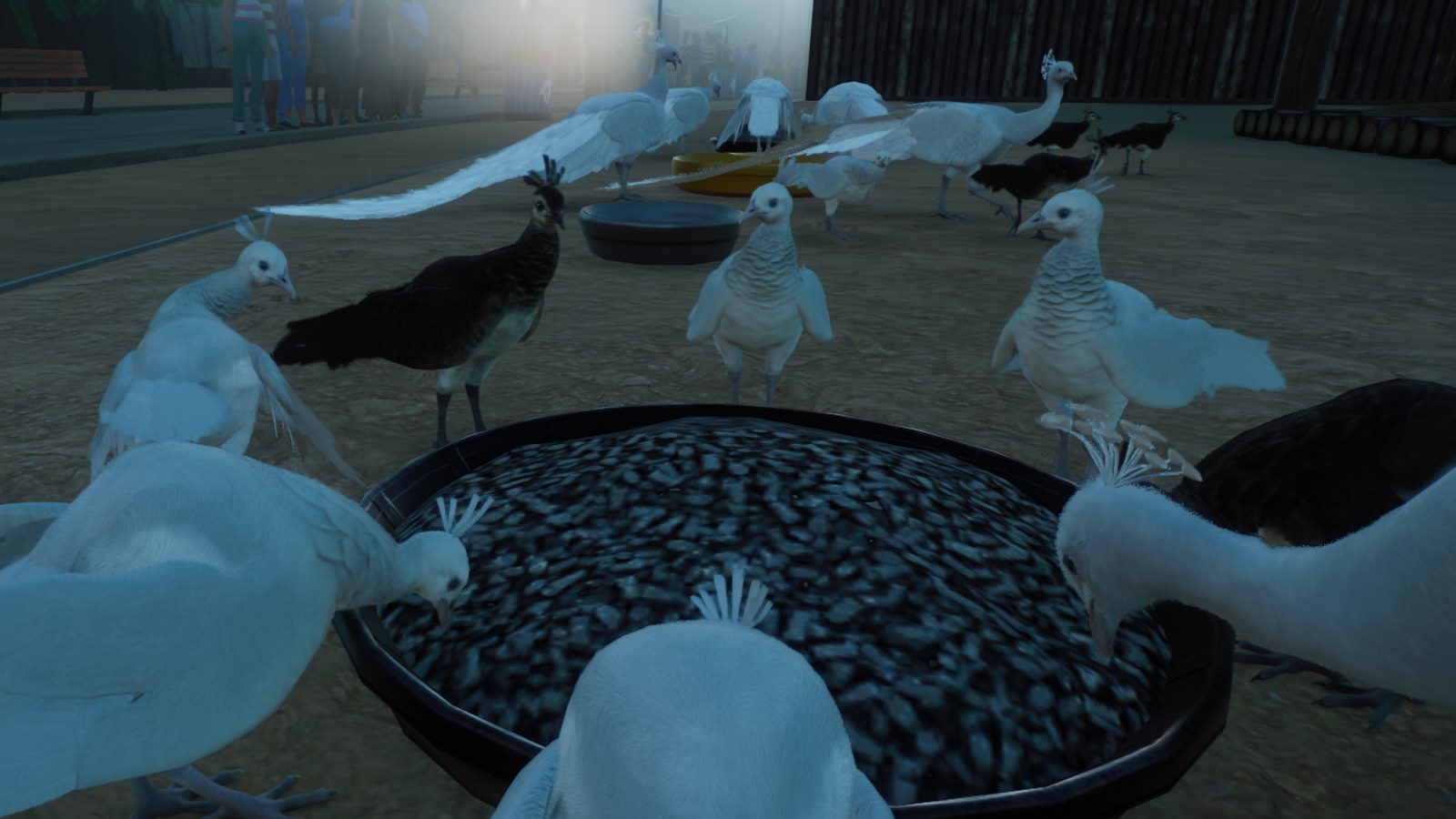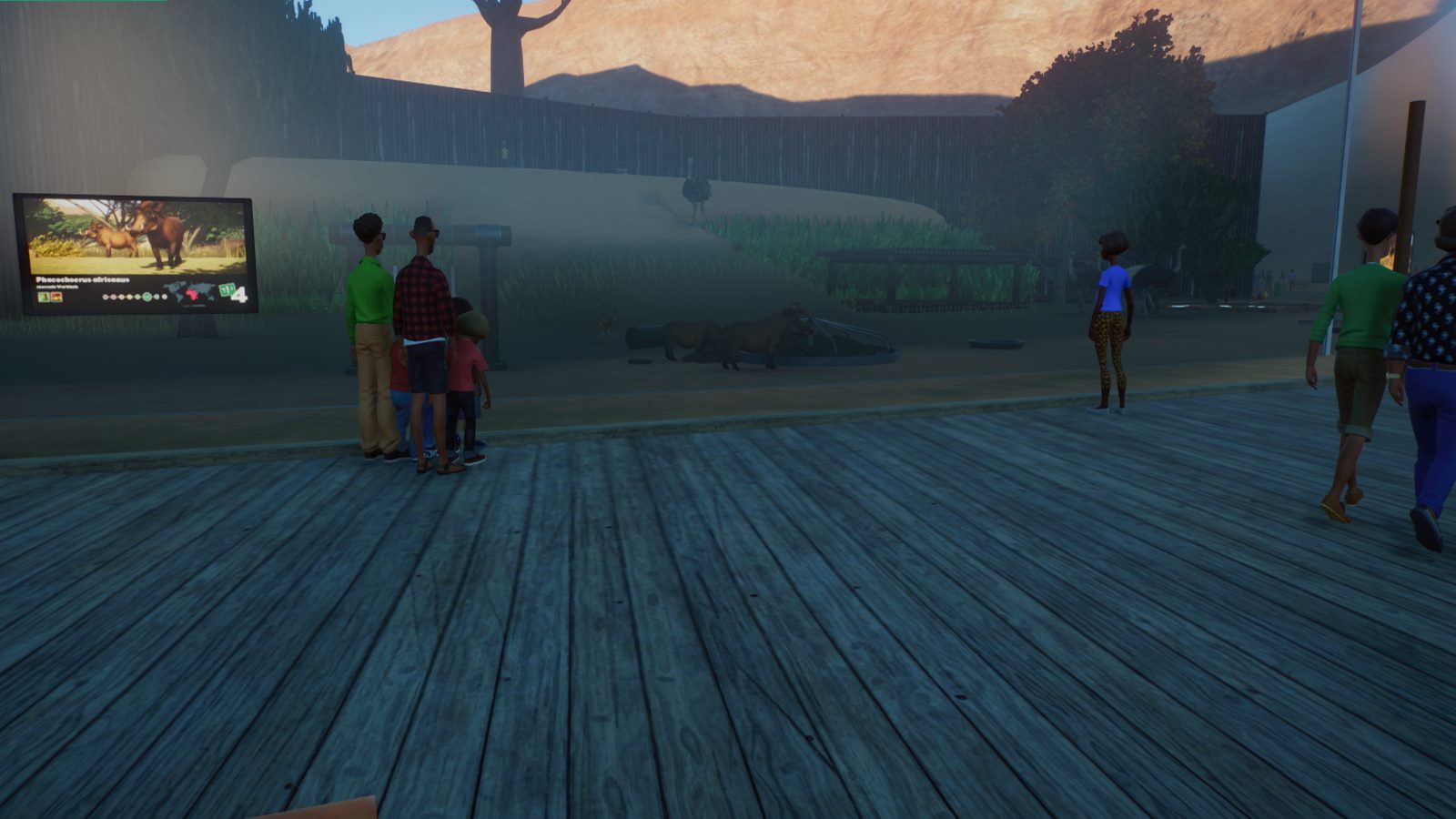Planet Zoo is, temporarily, a game about mass-producing knackered warthogs
Stop hogging the game
Something has... gone wrong with Planet Zoo. I think it'll be fixed easily enough, possibly even today, and I'm still having fun with it as it is. But, in the game's franchise mode at least, the promise of "build your own zoo, with whatever you like in it" has quietly been phased out for "in the grim darkness of the international animal trade, there is only warthogs".
Well, warthogs, ostriches and Indian peafowl, to be precise. Because, for anyone starting a game right now, that's pretty much all you can expect to see in your zoo for a good, long while. And you'll be seeing a lot of them, too, because grinding out millions of them is currently the best hope of you've got of getting other animals. It's very much a case of Go Pig or Go Home, and here's why.
The root of the current crisis, as is so often the case when weird metagames emerge from massive multiplayer systems, is Planet Zoo's simulated economy: the animal market, which lets anyone online buy and sell beasts from each other. It was working just fine when I reviewed the game. But any attempt to simulate an economy risks also simulating economics, which is what we call it when millions of individual, rational decisions act together to create utter madness on a grand scale. Now, unfortunately, economics has happened to Planet Zoo.
Here's what I think happened. And I stress "think", because economics is never an exact science, and I'm rubbish at it anyway. I've had to piece this all together from observations, deductions and a few forum posts over the weekend - but I think it makes sense.

PZ's animal market simulates the way real zoos swap animals, in order to keep gene pools diverse when trying to breed rare species for reintroduction to the wild. It runs on two currencies: money, and conservation credits (CC), which represent your good standing internationally, and which are earned through the release of captive-bred endangered animals. Animals can be listed for sale either for a cash price, or one in CC.
Since a new player franchise starts off with barely any CC, the idea was for fledgling zoos to buy a few animals with cash, foster breeding programmes for the endangered ones, and release them for CC. Eventually, this would earn them enough to buy the really cool animals, which tended to only be buyable for CC, and with hefty price tags to boot. Seems to make sense, right?
The problem was, it proved way easier to make money than it was to make CC, and so almost immediately, players stopped selling animals for cash - even with unendangered creatures, it was always more desirable to sell for CC, as that was the only way of getting the currency besides faffing about using your in-game avatar to visit other zoos.
Developers Frontier attempted fiscal stimulus, pumping cash-sale animals into the game from their own market presence, but it was not enough to change things. At the time of writing, Frontier animals are either being bought up the second they enter the market, or are not being listed at all, due to a potential bug.

In any case, the fact nobody is selling for cash has put CC at a massive premium: those who had got in early on endangered, prestige or hard-to-breed animals are now hoarding them, only selling them for wild sums. Prices have soared, making gorillas, tigers and the rest completely inaccessible to new players, while Pandas have become virtually mythical: beasts that might as well be made from pure diamond.
What was left to new players, with literally nothing on sale for cash? Well, those animals that fell into the Venn diagram intersection of "low prestige" and "unendangered", and were thus were neither hoarded, nor subject to the same rapid inflation as all the big ticket mammals. As the liquidity crisis set in, these animals became the stock in trade for new zoos, which began breeding them en masse in order to grind CC for lions or whatever.
This had two effects. Firstly, as the mass-produced offspring of the grindhouses flooded the market, CC values for these species plummeted still further. Secondly, those animals which bred faster or easier became more prominent in 'for sale' listings, as they were the ones proving most successful in the grinding operations.
It turned out "low prestige", "unendangered" and "fast-breeeding" boiled down to three creatures: the Indian peafowl, arguably the crappest animal in the game, plus ostriches and warthogs, which had the added bonus of being happy to cohabit, for more efficient mass breeding.

So where does all this leave us? In a vicious cycle, where the more people grind out the Big Three, the lower their value becomes, and the more of them people need to grind to afford anything else. A market dominated by dozens of pages of the same creatures, dotted with the occasional chimp or elephant, listed for a comically unattainable price.
Oh, and to make matters even more splendid, the animals people are selling on are the ones with genetic mutations that make them undesirable for further breeding - they might be highly susceptible to disease, tiny, incredibly short-lived, or even completely infertile. These sell for the lowest prices as well, naturally. Starting off as a new player, then, with your tiny pool of CC, you're going to be spending a lot of time scrolling through pages and pages of dying mutants, desperately seeking something that won't horrify your guests, and might have a chance of breeding.

Yes, once you do have a viable breeding population of the Big Three to start selling the kids of, there are what I call "stepping stone" animals. These are things like springboks, tortoises and monitor lizards, which you can buy for a few hundred CC (albeit often in a brutal state, DNA-wise - I bought a female tortoise who immediately collapsed with a serious injury), then begin to breed, selling the offspring on for commensurately higher prices. Eventually, doing things this way, the big cats will be yours.
But in my case, even getting a single breeding pair of galapagos tortoises, and a matching set of nile monitors, necessitated a huge amount of bargain-hunting on the animal market (when you see a good deal you need to snap it up immediately - wait even a few seconds and you'll be gazumped by the swarm of bastards doing the same thing), and a lot of hog grinding.

By the time I called it a night with my new zoo, I'd flogged dozens of Pumbaas, and two massive enclosures were packed with swarms of roaring, shagging pigs. Among them scampered legions of desperate ostriches, while over the other side of a fence, a steep-walled enclosure held a festering, ever-swelling singularity of breeding Indian peafowl.
Since you can only sell animals as adults, I was faced with regular population explosions of unshiftable young peafowl. As a result, the colony was regularly ravaged by plague, starvation and injuries due to brutal peckfights. Somehow, horribly, despite me laughing the prospect off as too grotesque in my review, the Bird Hole had become real.

Clearly, the situation isn't ideal. Apart from anything else, it's sad that a system meant to reward the emulation of real conservation practices has instead created a world where zoos are cynically churning out millions of genetically busted warthogs, into a wilderness where they're not even endangered.
I imagine hundreds of trucks constantly pouring over the kenyan border, reaching the edge of the savannah, and parking in massive staging posts, where grim-faced wardens throw open the doors to herd more and more packs of braying hogs onto the plain. In the distance, behind a wall of heat haze, the horizon teems with one billion emaciated, furious boars.
I mean, it's sort of amazing, as is Planet Zoo's bizarre new metagame as a whole. And if I'm honest, I'm really enjoying the challenge of trying to work my way out of warthog purgatory. It's the good kind of grind, where you feel you're building towards freedom in tiny, concrete increments. Well, apart from the time I spaffed 400 hard-earned CC on a sterile antelope, because I didn't read the listing properly. That was a blow.

Plus, of course, my beloved construction and landscaping tools are untouched, so there's no reason your three kinds of animals can't live in a total paradise. And don't forget, even if this situation isn't resolved quickly, there are still ways to play PZ with ethically acceptable levels of peafowl.
The sandbox mode, for example, lets you do whatever you like, while the 'challenge' mode is, as far as I can tell, exactly the same as Franchise mode, but is offline only. As such it contains an AI-run (and thus unborked) version of the animal market. Props to Frontier for adding the latter in response to player requests during the beta - if they hadn't have done, this situation would have been more irritating.
But come on - what are you doing still reading? Get out there and breed me some fackin warties.









